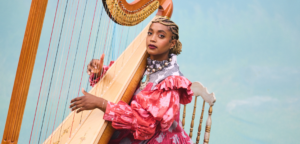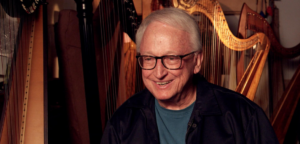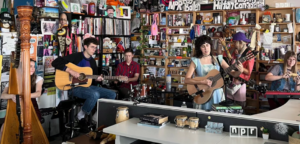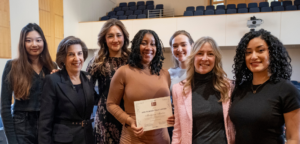If you’re a harpist, chances are the instrument you’re playing was built in your lifetime. The pedal harps needed for orchestra, the electric instruments becoming more ubiquitous in concert venues and jazz clubs, and the Irish harps designed to enhance Celtic music are almost always contemporary instruments. So when we heard that Elisabeth Plank is about to release an album using a harp built in the 19th century, we wanted to hear more about the experience. Below, she shares with Harp Column how she adapted to playing a period instrument and the interesting thematic elements woven into her historic harp album, 1825: Echoes of Vienna on Historical Harp, that drops May 17.
You have an album coming out next week! What inspired you to record early harp music?
Well… it wasn’t my intention in the beginning. I had mostly seen these historical harps in museums. For many years I had the idea to create a musical homage to my Vienna hometown, but wanted an idea for a unique approach. By chance I came across my historical double–action harp and suddenly it all fell into place.
So how did you pick the pieces on the album?
I mentioned that this CD is meant to be a musical homage to Vienna. The harp has a rich history here, but much of it got lost and forgotten.
Choosing the repertoire, I focused on the early 19th century and picked pieces by composers that had a connection to Vienna (Elias Parish–Alvars was the royal harpist here, Spohr and his wife Dorette worked in Vienna, to give two famous examples). It was also my intention to explore the origin of a style of writing specific to the harp that originated in that timeframe to show how revolutionary these pieces were at the time. I also wanted to contrast the Italian and “German/Austrian” style of composing, as this was an ongoing battle on Vienna’s stages in those days.
I did not want the album to only appeal to harpists, so I included some unknown pieces (even premiere recordings) together with well–known works to offer the opportunity to discover the differences between a period instrument and a modern harp.
Are you playing on an Érard harp?
I have recorded the album on a double-action harp by Érard that was built in 1825, hence the title.
Can you share your experience of adapting to a 19th century harp after so many years playing a modern double–action pedal harp?
In the beginning it was difficult because my reflexes are trained to a higher string tension and a bigger instrument. So I had to find a new sitting and playing position and create new reflexes for this harp. I consulted 19th century methods and also just tried to listen to what the harp wanted to tell me. My Érard was restored last year, so I was the first person to play it after a long time, and of course it needed some time to get used to being played again.
It was definitely worth the time and effort, because I learned so much from playing some of our core repertoire on the instrument it was actually written for! The pieces have so many more layers on a period instruments because of the different sound of these harps.
And in addition to all of that, you were just selected for a residency at the Wiener Konzerthaus—congratulations! What exactly does this Great Talents program entail?
All “Great Talents” get selected for two seasons. During this period, we perform solo recitals, as soloists with orchestra, and chamber music with other “Great Talents” or renowned musicians at the Wiener Konzerthaus, Musikverein Graz, and Oberösterreichische Stiftskonzerte. So it also gives us the chance to create a network with important Austrian concert venues and other musicians. A lot of publicity comes with it as well; we are featured in the annual subscription brochure, on the homepage, and on posters all over Vienna. A few days ago, a musician came up to me and said, “Hey, I know you! I saw you in the new Konzerthaus brochure!”
I know you are the first harpist to be chosen; what was the application/audition process like?
There is no application process in the traditional sense. The Wiener Konzerthaus apparently keeps track of young musicians and then invites the most promising ones. This recognition by one of the major concert halls of the world with such an unusual instrument is in itself an honor for me.
One last question—the city of Vienna has obviously had a huge impact on your musical education. Can you share with readers what it is like to be a musician in Vienna? For those of us who have never been, what should we know about the arts scene there?
To give an example: Vienna is a city of contrasts. It is the second largest city in German speaking areas, but it still feels like a sleepy town sometimes. Vienna is definitely a city of culture, history, and music, but as a harpist it is hard because the harp is not an instrument easily accepted on the stage as it is hardly seen anywhere but in the orchestra.
There are lots of specific playing traditions for various instruments (mainly strings, oboe, French—or rather Viennese—horn) as well as traditions of musical interpretation, especially for works by composers who worked in Vienna. Musikverein, Konzerthaus, and Staatsoper have performances almost daily (but they are closed during July and August, so summer is not a good time to come if you want to listen to concerts). The world’s best orchestras play in Vienna, but you can also find innovative new opera productions, festivals for contemporary music, and jazz. But the most amazing thing—and here we have another contrast—you can have all this culture on a budget! The big and famous venues offer cheap tickets (usually in the standing area) so you can listen to a concert in the Golden Hall of Musikverein for just 5€.
Vienna is full of culture and history, but sometimes it is hard to balance past and future; sometimes we rest on our glory [days] and forget to look forward.
Click here to watch the trailer for 1825 or visit www.elisabethplank.com to learn more.











